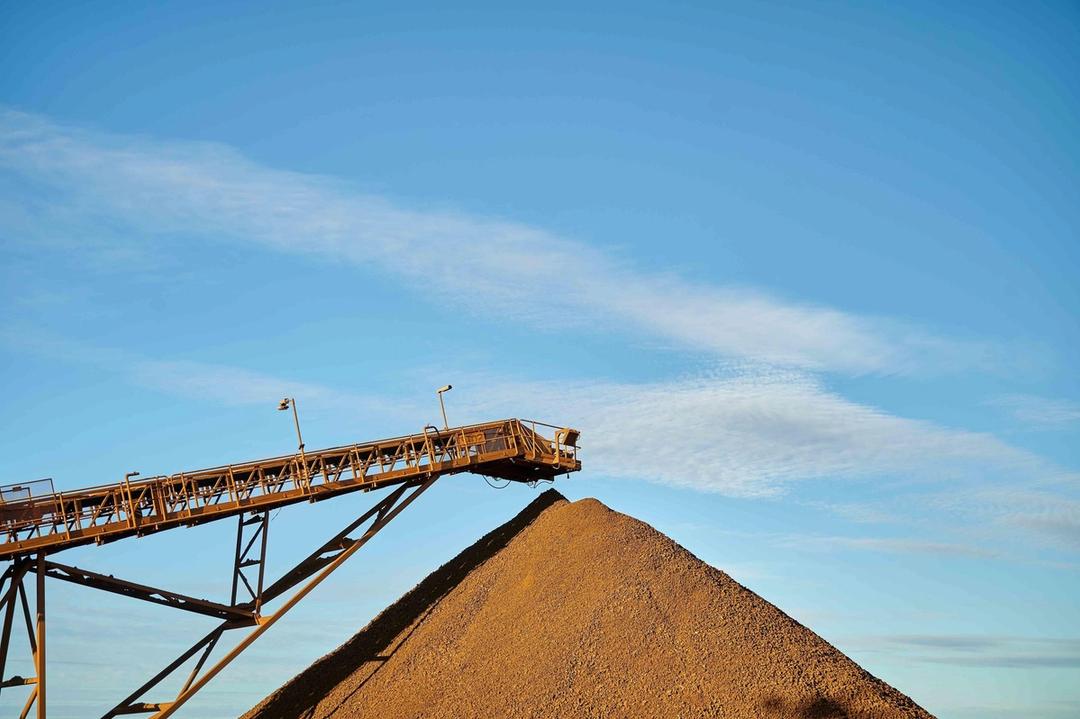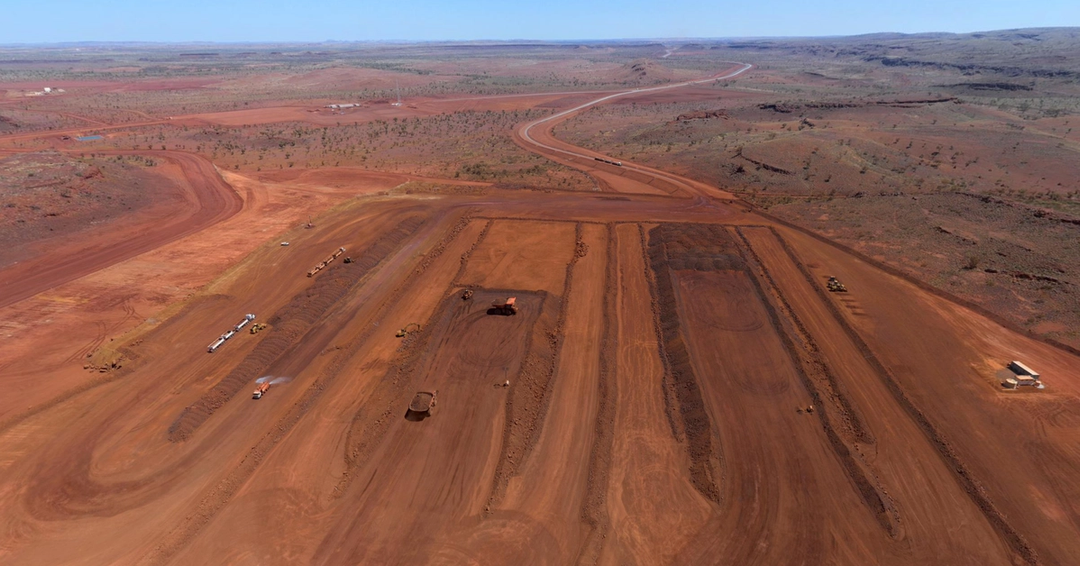With a nameplate capacity of 35 million tonnes per annum (Mtpa), Onslow Iron’s innovative pit-to-ship supply chain is now unlocking what many considered to be stranded assets in the West Pilbara region.
And with mining operations gathering steam at the Ken’s Bore mine site and MinRes transhippers ferrying iron ore out of the Port of Ashburton, it’s the long-life infrastructure linking these two locations – Onslow Iron’s dedicated private haul road – which is playing a critical role in unlocking the project’s true value.
A transformational opportunity
In 2021, through the haze of the COVID-19 pandemic, MinRes took steps to seize an opportunity to transform the company and in September of that year announced the acquisition of a stake in the joint venture (JV) owning the Onslow Iron project.
The original JV had formed 15 years earlier and spent hundreds of millions of dollars on studies and resource definition works with limited progress. As a result, markets had largely written off the project citing high capital costs and logistical challenges progressing the project to development.
Unperturbed, MinRes pushed ahead with planning and pre-feasibility studies and in August 2022 announced a successful Final Investment Decision (FID), largely influenced by the company’s track record for applying in-house expertise and an innovation mindset to address project challenges – which for Onslow Iron there were several.
Firstly, significant capital investment for mining infrastructure would be addressed with the support of MinRes’ wholly owned subsidiary and mining services leader, CSI Mining Services, unlocking value through its end-to-end supply chain capability.
A key aspect of CSI’s unique build-own-operate business model would be put to work via its proprietary NextGen modular crushing technology and its above-ground design, constructed in around a third of the time and at a fraction of the cost of traditional fixed crushing plants.
Traditionally, exporting product through the Port of Ashburton also involved burdensome costs and environmental impacts associated with building a deep-water port. These challenges would be overcome through MinRes’ design and development of 20,000 tonne transhippers, each producing a shallow seven metre draft when fully loaded.
With a fleet of five purpose-built vessels supporting Onslow Iron at nameplate capacity, marine operations would transport iron ore to ocean going vessels anchored 40km offshore without the need to construct a deep-water port.
But one of the most pressing project challenges was a cost-effective way to transport iron ore 150km from Ken’s Bore to the Port of Ashburton, for which a traditional heavy rail system was deemed cost inhibitive.
The proposed alternative would leverage the expertise of MinRes’ in-house Engineering and Construction division to lead the design and development of a dedicated private haul road from pit to port, servicing a fleet of CSI jumbo road trains operating around the clock.
A planned transition to fully autonomous operations would then deliver the ultimate road haulage solution and support improved safety, efficiency and productivity from mine site to port.
With a supply chain solution confirmed and a clear roadmap to bring Onslow Iron to life, MinRes pushed ahead with development of its largest and most innovative project – delivering first ore on ship in less than two years from FID.

Breaking new ground in heavy transport
In developing a bespoke road transport solution for Onslow Iron, MinRes engineers and third party designers needed to overcome one of the project’s most pressing challenges: unprecedented loads and trip frequencies of its jumbo road trains.
Importantly, each MinRes road train boasts a 20-tonne axle weight, significantly heavier than the standard eight-tonne axle weight for trucks running on typical Western Australian roads. At nameplate capacity of 35Mtpa, the road will facilitate a vehicle movement every 2.9 minutes.
MinRes Chief Executive Engineering and Construction Darren Killeen said an initial challenge was developing a haul road unlike any conventional thoroughfare in Australia.
“We worked closely with Main Roads WA (MRWA) on the design and they have prescriptive guidelines for road pavement design detailing what you do and how you do it,” Killeen said.
“Their guidance has been developed off the back of years of empirical data to Western Australia’s conditions – the charts basically tell you how thick each of your road layers should be.
“But we go off the chart with a high frequency of 20-tonne axle weight cycles, so we had to undertake a range of testing to find out where our road fits and the required measurements.”
Darren said while MinRes’ in-house expertise had supported the design and construction of many roads for heavy loads, Onslow Iron’s haul road application presented a unique application for the team.
“The forgiveness you’d find on a typical road is very high, there’s a low number of eight-tonne axle weight vehicles. But on the Onslow Iron haul road we have 120 20-tonne axle weight jumbo road trains running around the clock,” he said.
Alongside MRWA, MinRes engaged worldwide road pavement experts Tetra Tech Coffey to provide the design, with the final design resembling a combination of airport runway and port terminal standards.
To create a long-life transport asset, MinRes developed the haul road with five layers, starting with the in-situ foundation – the natural ground – which presented another test.
“We had probably 10 or so different ground conditions the road had to be designed around,” Killeen explained.
“At the Port of Ashburton, for example, we were contending with daily water inundation due to tidal factors, then we might have been on a salt flat, then you get to the mine and it’s very typical Pilbara gravel.”

Transitional fill made up the next layer at depths dependant road height at different sections and based on projected flood levels and road gradients.
Considered the first level of the pavement, the sub-base layer is comprised of a higher-quality material, followed by the base course containing the best quality material.
Chip seal presents the penultimate layer – between 10 and 25mm thick – before 40mm of asphalt tops the road.
Safety has also remained at the fore with the haul road designed two metres wider than typical public roads used for heavy haulage in the Pilbara, spanning 11 sealed metres from edge to edge.
The lanes themselves each measure 4.2m wide, with a further 500mm of asphalted shoulder and plus 800mm of sealed shoulder on either side.
Each MinRes road train travels in the centre of its lane, ensuring passing trucks remain 1.65m apart thanks to a clearance of 830mm on each side.
By comparison, two standard 2.5m wide road trains travelling on a typical public road would pass each other just one metre apart with 500mm to each side.

Challenges also came in the form of safely managing intersections with public roads, with three underpasses developed in conjunction with MRWA at North West Coastal Highway, Onslow Road and Mt Stuart - Red Hill Station Road.
Passageways eliminate interactions between jumbo road trains and public vehicles, while fencing the entire length of the road helps safeguard animal welfare.
While the Onslow Iron haul road achieved practical completion in November 2024, flooding from severe tropical cyclones in February 2025 coupled with high temperatures, water and load prompted the decision to upgrade the road and future-proof the asset.
Works include seal binder upgrades and cement stabilisation - increasing pavement strength and the road’s resistance to moisture - and asphalting the entire length of the road. Together, these measures further counter the Pilbara’s harsh weather conditions and promote driver safety and continuity of operations.
Supporting autonomous haulage
MinRes’ planned transition to world-first autonomous haulage would not be possible without several critical technological components within the Onslow Iron haul road.
The company partnered with autonomy specialists Hexagon to deliver autonomous technology which will guide road trains 150km from Ken’s Bore to the Port of Ashburton.
Features include roadside monitoring bases with thermal imaging cameras using artificial intelligence to support early identification of potential issues with wheels, brakes and flat tyres.
Service bays are also located one kilometre from monitoring systems, providing trucks with ample time to pull into the bay if needed.
Data from the roadside monitoring bases and the trucks themselves are fed to a control room at MinRes’ Truck Maintenance Facility, just outside of Onslow, which is overseen by experienced operators 24 hours a day.
A focus on communication and safety will be supported throughout the 150km journey by private 4G mobile communication systems using fibre networks.

A partnership driving value
MinRes’ dedicated private haul road is the first of its kind globally and set to underpin Onslow Iron’s unique supply chain for decades.
Even in the early months Onslow Iron's production ramp-up to nameplate capacity, the 150km carriageway linking Ken’s Bore to the Port of Ashburton was already being recognised as a valuable asset.
This was reinforced in June 2024, when MinRes announced it had entered into a binding agreement with Morgan Stanley Infrastructure Partners for the sale of a minority stake in the haul road.
The deal was rubber stamped by the Foreign Investment Review Board three months later, paving the way for MinRes to sell a 49% interest in the road for up to $1.3 billion.
At the time, Managing Director Chris Ellison acknowledged the strategic relationships MinRes has formed with global industry leaders and welcomed Morgan Stanley Infrastructure Partners as a partner in the Onslow Iron haul road.
“This transaction is a strong endorsement of Onslow Iron’s world-class credentials, after the project last month delivered first ore on ship ahead of schedule,” Ellison said.
“As the first transaction of its kind in the Australian iron ore industry, it showcases the considerable value of MinRes’ portfolio of infrastructure assets and our ability to unlock significant capital.
“The transaction also establishes access to a new pool of capital to further accelerate our growth and continue to deliver returns for our shareholders.”

Bringing Onslow Iron to life is testament to the vision and determined culture within MinRes.
As the biggest and most innovative project the company has ever delivered, Onslow Iron harnesses in-house technology and expertise to identify and unlock opportunity where others couldn’t.
This innovation is now on display from pit to ship, connected by a complex piece of transport infrastructure engineered for unprecedented loads, designed for safety and efficiency, and future-proofed for reliability and returns.




